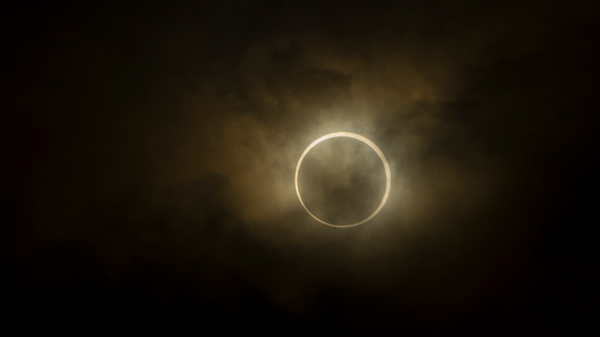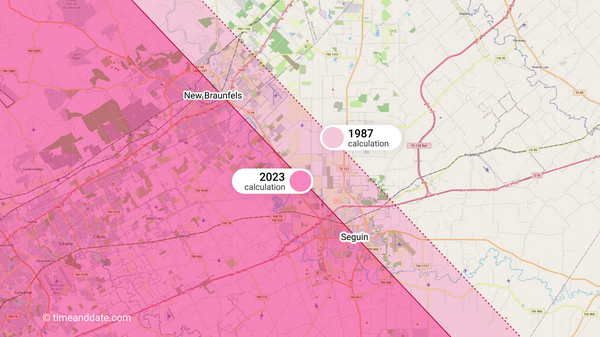The Texas Cities That Lost a Solar Eclipse
New Braunfels and Seguin in Texas were predicted to be within the path of annularity for the solar eclipse on October 14, 2023. But Earth had other ideas.

A view toward New Braunfels, part of the Greater San Antonio metropolitan area in Texas. On October 14, 2023, the edge of a solar eclipse path will divide the city in two.
©iStockphoto.com/dszc
Earth Speeds Up, with Consequences
In recent years, for reasons that are not well understood, Earth’s spin has speeded up. Here at timeanddate.com, we’ve been keeping track of our planet’s rapid rotation:
- 2020—Earth records its 28 shortest days since the invention of atomic clocks
- 2021—Earth’s ongoing speed raises the possibility of a negative leap second
- 2022—Earth sets a new record for the shortest day of the atomic clock era
Over many years, small changes in the speed of Earth’s rotation can add up to many seconds. Even so, for most of us, this has little impact on our lives.
But there is a group of people for whom it can have significant consequences: residents of towns and cities near the edge of a solar eclipse path.
Watch the October 14, 2023, solar eclipse LIVE

In the solar eclipse across North and South America on October 14, 2023, annularity—where the Sun forms a ring of fire around the Moon—will be visible along a path roughly 190 km or 120 miles wide. The Texas cities of New Braunfels and Seguin lie on the edge of this path.
©iStockphoto.com/m-ikeda
How This Affects Eclipses
Eclipse calculations include a number that accounts for changes in Earth’s rotational speed. This number is called Delta T. It is usually written as ΔT, using the Greek letter Δ (Delta), and is measured in seconds.
For eclipses in the future, ΔT is only an estimate, because we don’t fully understand the mechanisms that affect Earth’s spin. It is a complicated combination of the motions of our planet’s liquid core, oceans, and atmosphere, plus other factors.
This affects our calculations: if Earth spins more quickly than we expect, the Moon’s shadow will strike the ground more to the west than we anticipate.
A 1987 Estimate versus Today’s Value
In 1987, NASA published a renowned reference book called the Fifty Year Canon of Solar Eclipses: 1986-2035. The author was Fred Espenak, an astrophysicist known within the astronomy community as “Mr. Eclipse.”
Next to its map and other details for the October 2023 annular eclipse, the book gave an estimated ΔT value of 85.3 seconds.
Over the 36 years since 1987, however, Earth has rotated more quickly than predicted: the actual value of ΔT in October 2023 is only 69.2 seconds.
This difference of 16.1 seconds shifts the path of annularity about 6.5 km or 4.0 miles to the west.
For towns and cities that are well within the path of annularity, this makes little difference. But for places near the edge—like the cities of New Braunfels and Seguin in Texas—it can be the difference between getting annularity, or not.
How the Eclipse Path Has Shifted


This map compares two calculations of the path of annularity for October 14, 2023. One calculation was done in 1987, using an estimated ΔT value of 85.3 seconds. The other was done in 2023, using an actual ΔT value of 69.2 seconds. The path has shifted 6.5 km or 4.0 miles to the west.
©timeanddate
The red line running diagonally across the above map shows the northern edge of the path of annularity for the solar eclipse of October 14, 2023.
To the south of this line, in the pink-shaded area, an annular eclipse—where the Sun forms a complete ring around the Moon—is visible.
To the north of the red line, annularity is not visible: observers will see a very deep partial eclipse that almost, but doesn’t quite, form a complete ring.
According to the 1987 calculation of the eclipse, New Braunfels and Seguin were within the path of annularity.
The 2023 reality is that the edge of the annularity path will run through the center of both cities, dividing them in two.
The southwestern parts of New Braunfels and Seguin will see an annular eclipse; the northeastern parts will see a very deep partial eclipse.
Find New Braunfels and Seguin on our interactive eclipse map
Other Uncertainties
It should be noted that other factors can affect the accuracy of eclipse predictions, particularly near the edges of eclipse paths.
These range from the elevation of the observer above sea level, to margins of error in estimations of the size of the Sun.
Delta T Uncertainty Is Here to Stay
So New Braunfels and Seguin are the cities that almost lost an annular eclipse.
Looking ahead, changes in the speed of Earth’s rotation will remain an unknown factor that affects the calculation of eclipse paths in the future.
As Fred Espenak wrote in his Fifty Year Canon back in 1987: “As we progress into the twenty-first century, the value for Delta T will inevitably diverge from the extrapolated ones.”

Half in, half out: on October 14, 2023, the northern edge of the annular eclipse path will run through the center of Seguin, Texas, about 50 km or 30 miles from San Antonio.
©iStockphoto.com/Thomas Faull